- There are no more items in your cart
- Shipping Calculated at checkout
- Sub-Total (inc. VAT) £0.00
Need Help?
Metal Primers, Intermediates and Undercoats
Metal primers are essential for ensuring the longevity and effectiveness of paint systems applied to metal surfaces. The product category content below discusses the necessity, benefits, application methods, types, and preparation techniques of metal primers, catering to DIY/domestic projects, commercial enterprises, industrial applications, and agricultural settings. Using the correct metal primer with not only give superior adhesion, allow better coverage, and stain hiding power, it will also protect the underlying metal from rust. Click for more info.
Subcategories
- Adhesion Primers
- Anti-Corrosive Primers
- Immersed Environment Primers
- Intermediates
- Low Temperature Primers
- Moisture Tolerant Primers
- Quick Drying Primers
- Rust Converters
- Shop Primers
- Surface Tolerant Primers
- Zinc Rich and Cold Galvanising Paints
- Zinc Silicate Primers
- Zinc Phosphate Primers
- Water-Based Primers
- High-Build Primers
- Blast and Holding Primers
- Undercoats
- Micaceous Iron Oxide (MIO) Paints
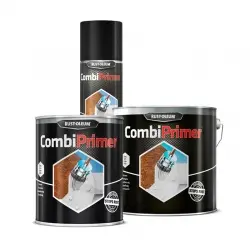
Rust-Oleum 3369/3380 CombiPrimer Anti-Corrosion
Available in grey and red, can or aerosol. Two-pack anti-rust primer for new or slightly rusted surfaces. For steel surfaces, provides and enhance protection against corrosion. Recoatable after 2 hours; fast drying and lead- and chromate-free. 5-year shelf life if stored properly.
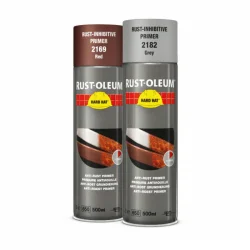
Rust-Oleum Hard Hat 2169/2182 Anti-Rust Primer
Available in Red-Brown and Grey. For new, bare, or slightly rusted steel surfaces. Touch dry in 15 minutes, ready to handle in 30. Lead and chromate-free. Can be recoated within 1 hour.
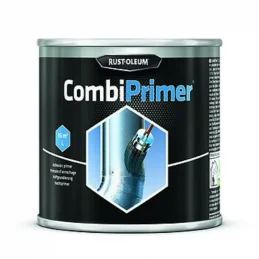
Rust-Oleum 3302 CombiPrimer Adhesion Primer
Available in a transparent blue finish. Highly effective adhesion primer for ensuring smooth surfaces are coatable. For galvanised steel, stainless steel, aluminium, copper, glass, and porcelain. High coverage of 50 m²/L. Recoatable after just 30 minutes.
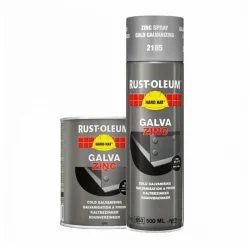
Rust-Oleum Hard Hat 2185/1085 Galva Zinc
Available in dark grey. Aerosol spray providing cathodic protection with 90% pure zinc content in the dry paint film. For bare and galvanised steel surfaces. Resists up to 500 hours of salt spray testing. Touch dry in 10 minutes. Heat resistance up to 450°C.
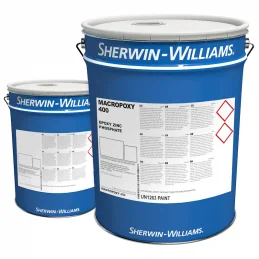
Sherwin-Williams Macropoxy 400
Formerly known as Sherwin-Williams Macropoxy C400V3, a multi-functional epoxy zinc phosphate coating suitable for the protection of steelwork in a range of exposure environments from C1 to C5. It was recently used on The Shard (London) for corrosion protection. Recommended uses include:Buildings, car parks Petrochemical plants, breweries,...
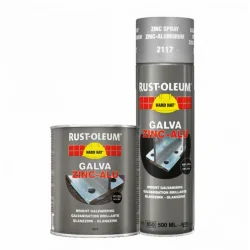
Rust-Oleum Hard Hat 2117/1017 Galva Zinc Alu
Available in a silver finish with aluminium particles. For use on galvanised steel surfaces and metal. Provides cathodic protection. Fast drying: touch dry in 20 minutes. Heat resistant up to 450°C. Suitable for corrosive environments and high humidity areas.
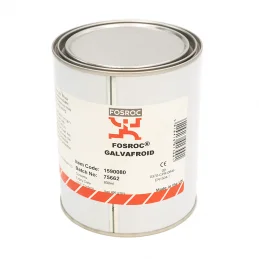
Fosroc Galvafroid
Fosroc Galvafroid is a zinc rich coating formulated as an easily applied, cold galvanising protection against corrosion on all ferrous metals with a mid-grey, matt finish.Specifically designed to provide rust inhibiting protection to ferrous metalwork Complies with LU Standard 1-085 ‘Fire Safety Performance of Materials’Please note:...
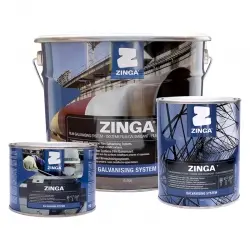
Zinga
Zinga is a one-component anti-corrosion zinc coating system that provides cathodic protection to steel comparable with hot-dip galvanising, with the added advantage that it can be applied as though it were a paint, and is certified to not spread flame or create smoke (BS476 parts 6&7).Can protect longer than hot-dip galvanising (at the...
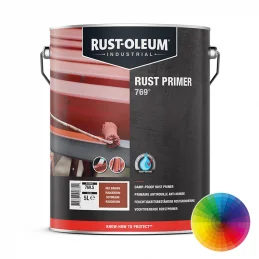
Rust-Oleum 769/780 Damp-Proof Rust Primer
Available in a wide range of colours. Ideal for application on slightly damp or dry metal surfaces. Requires minimal surface preparation. Durable corrosion protection. Optimal rust inhibition. Certified for C4 exposure conditions (ISO 12944) and VOC compliant (375 g/l).Buy A Paint Colour Sample
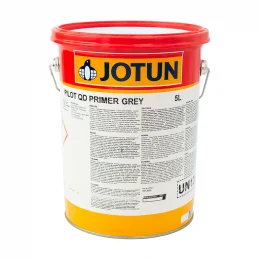
Jotun Pilot QD Primer
A primer with 6 colours available that can be applied to steel, aluminium or wood, and features very good adhesion properties on all these substrates.Anti-corrosive One component Oxidatively drying alkyd coating Fast drying High build Zinc phosphate pigmented
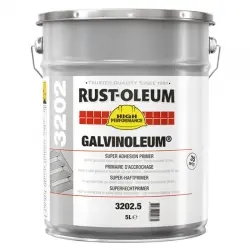
Rust-Oleum 3202 Galvinoleum Primer
Available in translucent blue. Primer for galvanised steel, plastics, and other smooth surfaces. Recoatable after just 30 minutes, providing a high coverage of 50 m²/l. Offers excellent adhesion.
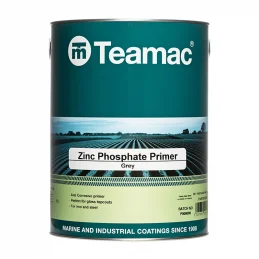
Teamac Zinc Phosphate Primer
In Red or Grey. High-performance anticorrosive metal primer. For iron, steel, and other metal surfaces such as fire escapes, metal gates, and garage doors. Usable in marine environments. Semi-matt finish. Excellent adhesion and durability.
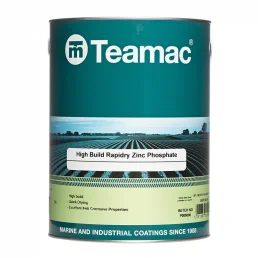
Teamac Rapidry HB Zinc Phosphate Primer
In Red, White or Grey. High-performance, quick-drying anticorrosive metal primer. For iron and steel surfaces, particularly in coastal environments where rapid coating and finishing are required. Semi-matt finish. Robust protection against corrosion.
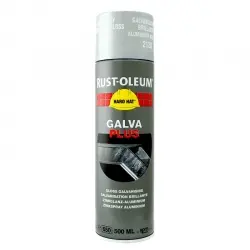
Rust-Oleum Hard Hat 2120 Galva Plus
A fast-drying zinc/aluminium coating available in Silver. Ideal for touch-ups on galvanised steel surfaces. Resists 310 hours of salt spray testing. Contains lower zinc content and more aluminium. Recommended for light industrial exposures and corrosive environments. Ensures a metallic, matt finish for aesthetic consistency.
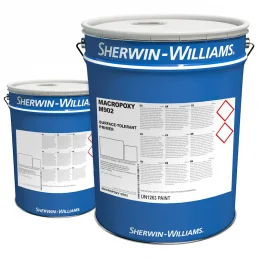
Sherwin-Williams Macropoxy M902
Sherwin-Williams Macropoxy M902 (formerly known as Epigrip M902) is a low temperature curing hi-build 2-pack epoxy brushing aluminium primer coating capable of curing down to 0°C. For brush application onto hand or mechanically prepared surfaces and/or damp gingered surfaces giving excellent wetting and adhesion characteristics - see...
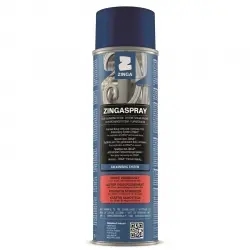
Zinga Zingaspray
The Zinga film galvanising system in the convenience of a 500ml aerosol spray can. Use to repair or touch up galvanising, damaged or old hot-dipped, other zinc coated structures or products previously treated with Zinga in marine structures, new steel and galvanising, cast-iron and aluminium alloys.Repair for worn or damaged hot-dip...
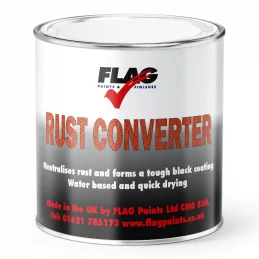
Flag Rust Converter
Flag Rust Converter is a high performance water based low odour and environmentally friendly primer treatment which neutralises rust and forms a tough black surface. It prevents rust re-occurring and is quick drying and easy to use.For interior and exterior use Suitable for over-coating with solvent based primers or top coats For use on...
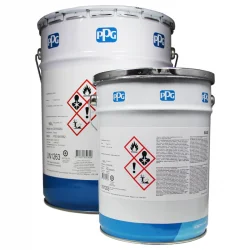
PPG SigmaCover 435
PPG SigmaCover 435, two-component, high-build, micaceous iron oxide-pigmented, polyamide-cured recoatable epoxy coating. Used as a buildcoat or finish in protective coating systems, for steel and concrete structures exposed to atmospheric land or marine conditions, curing at temperatures down to -10°C (14°F).A high relative humidity...
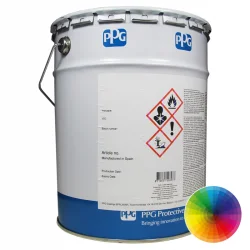
PPG SigmaFast 20
PPG SigmaFast 20 is a high-build zinc phosphate primer based on modified alkyd resin, with good anticorrosive properties under atmospheric conditions. The primer can be specified as a single coat, direct-to-metal system for ISO 12944 C1 and C2 environments.Available in 2,600+ colours, inc. RAL, BS, NCS & the new NCS 2050 colours Fast...
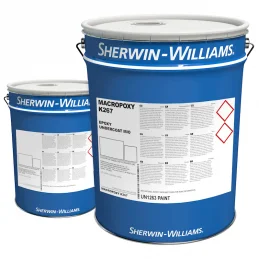
Sherwin-Williams Macropoxy K267
Sherwin-Williams Macropoxy K267 (formerly known as Epigrip K267/Transgard TG121) is a two-pack, pigmented with micaceous iron oxide, designed as an intermediate coat in conjuction with Macropoxy high performance primers.
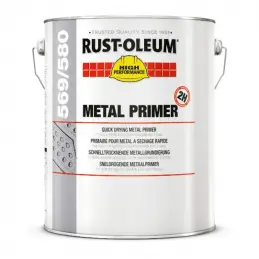
Rust-Oleum 569/580 QD Metal Primer
In Red-Brown or Grey. Quick drying metal primer. For new, blasted, or lightly rusted steel surfaces. Recoatable after just 2 hours. Professional use only. 5-year shelf life guarantee.
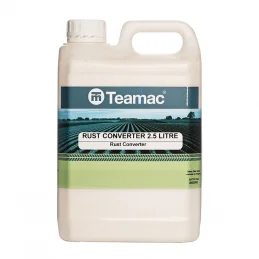
Teamac Rust Converter
Corrosion inhibitor and rust converter. Dries to a black finish. Ideal for use on iron and steel where rust cannot be fully removed. Non-flammable with a low sheen finish.
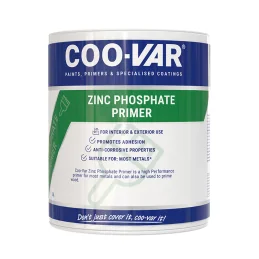
Coo-Var Zinc Phosphate Primer
Modified alkyd metal primer. Anti-corrosive protection on iron and steel, available in red and grey colours. For iron, steel, aluminium, and combined wood and metal structures, including fire escapes, metal gates, and garage doors.
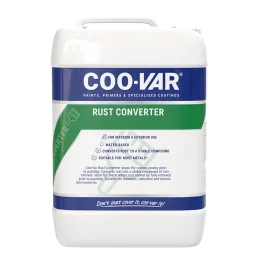
Coo-Var Rust Converter
Designed to convert rust on iron and steel surfaces. Darkens upon drying. For iron, weathered steel, structural metalwork, and tools. Non-flammable with a low-sheen finish.
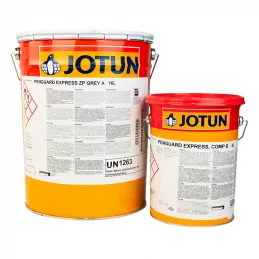
Jotun Penguard Express ZP
A two component amine cured epoxy coating that is a fast drying, zinc phosphate pigmented, high solids, high build product. Specially designed for new construction where fast dry to handle and over coating times are required. Can be used as a primer, mid coat, finish coat or as a single coat system in atmospheric environments.
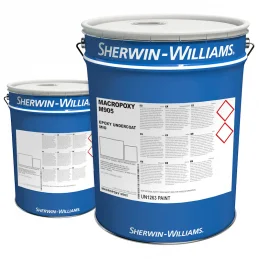
Sherwin-Williams Macropoxy M905
Sherwin-Williams Macropoxy M905 (formerly known as Epigrip M905) is a low temperature curing, two pack epoxy high build undercoat, capable of curing down to 0°C.For application onto suitably primed surfaces, as an undercoat for use under suitable high performance finishes, where low temperature curing is required Recommended for rapid...
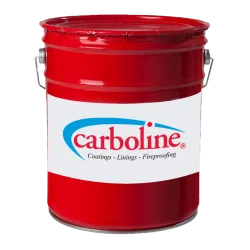
Carboline Carbomastic 15 LT
Carboline Carbomastic 15 LT is a two-component, high build coating with excellent adhesion to rusted steel and most aged coatings.Surface tolerant Recommended for painting over rusted steel where hand cleaning only is possible Carbomastic 15 LT penetrates through rust to steel substrate and stops further corrosion and undercutting...
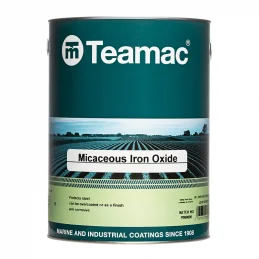
Teamac Micaceous Iron Oxide
Available in Silver Grey. Protective paint, designed to provide anti-corrosive protection for steel surfaces. For structural steel, including buildings, bridges, and other metal surfaces. Usable as a finishing coat, or overcoatable with a topcoat.

Coo-Var Water Based All Metals Primer
In Matt Red or Grey. Water-based metal primer for anti-corrosive protection. For iron, steel, aluminium, brass, copper, and galvanised surfaces. Enhances adhesion for topcoats. Non-flammable and low VOC.
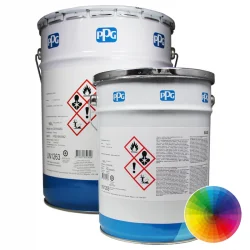
PPG SigmaCover 456
PPG SigmaCover 456, a two-component, high-build, polyamide-cured recoatable epoxy coating available in 2,600+ colours, for steel and concrete structures exposed to atmospheric land or marine conditions, curing at temperatures down to -10°C (14°F). SigmaCover 456 can be recoated with various two-component and conventional coatings, even after...
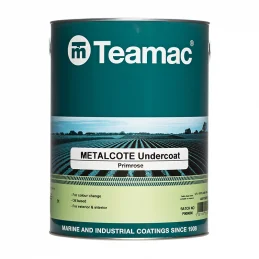
Teamac Metalcote Undercoat
In White, Black, Grey, Primrose, Buff, and Red. For wood, ferrous metals, and GRP surfaces. Internal or external use. Oil-based formula with excellent flow characteristics. VOC compliant with a maximum content of 437 g/l.

Jotun Penguard Primer
Jotun Penguard Primer is a two component polyamide cured high molecular weight epoxy coating designed as a primer for new construction. It can be used as a primer as a part of a complete system in atmospheric and immersed environments. Suitable for properly prepared carbon steel, stainless steel, aluminium, concrete, galvanised steel, shop...
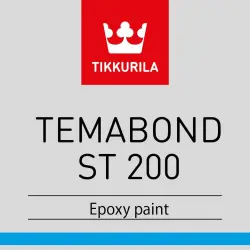
Tikkurila Temabond ST 200
2 component high-solids, aluminium pigmented modified epoxy maintenance paint for demanding surfaces such as steel structures, railway vehicles, and infastructure in energy and telecommunications.Surface-tolerant high-solids epoxy paint. Very good adhesion even to hand-prepared steel. Lower VOC emissions than conventional epoxy paints....
Need Help?
Need Help?
Why Metal Primers Are Needed
Metal primers serve as the foundational layer in a painting system, providing several essential functions:
- Corrosion Protection: Metals, especially those exposed to moisture and air, are prone to oxidation and rust. Primers contain corrosion inhibitors that shield the metal surface from these elements.
- Adhesion Enhancement: Primers create a suitable surface for the topcoat to adhere to, ensuring that the paint does not peel or flake off easily. This is particularly important for smooth or minimally prepared metal surfaces.
- Surface Smoothing: Primers help to fill in minor imperfections, providing a smoother and more uniform surface for the topcoat. This results in a more aesthetically pleasing finish.
- Chemical Resistance: In industrial and agricultural settings, metal surfaces might be exposed to chemicals. Primers can offer an additional layer of protection against chemical reactions.
Common Metals That Require Priming
While all metals can benefit from priming, some require it more than others due to their susceptibility to corrosion and other forms of degradation:
Steel: Highly prone to rust, especially when exposed to the elements. Priming is essential to prevent corrosion.
Iron: Similar to steel, iron corrodes easily and needs a primer for protection.
Aluminium: Although it doesn’t rust like steel or iron, aluminium can oxidise, leading to surface pitting. A primer helps in adhesion and prolongs the finish.
Galvanised Metal: Priming is necessary to ensure proper paint adhesion due to the zinc coating.
Copper and Brass: These metals can tarnish and develop a patina. Primers help in preserving their appearance and ensuring paint adhesion.
Benefits of Using a Primer
Even with direct-to-metal (DTM) paints, using a primer can provide additional benefits:
Enhanced Durability: Primers add an extra layer of protection, making the overall coating system more robust.
Better Coverage: Primers often have high pigment content, which helps in covering up the underlying metal and achieving a uniform finish with fewer topcoat layers.
Cost Efficiency: Priming can reduce the number of topcoat layers needed, thus saving on paint costs.
Extended Paint Life: The primer acts as a barrier, extending the life of the topcoat by preventing issues like peeling and blistering.
Application Methods
Applying metal primer correctly is crucial for achieving the desired protective and aesthetic results. Here are some common application methods:
Brushing: Suitable for small areas or touch-ups. Ensure even strokes and proper coverage.
Rolling: Effective for larger flat surfaces. Use appropriate rollers designed for metal primers to avoid bubbles and streaks.
Spraying: Ideal for large or complex surfaces. Provides a smooth, even coat but requires proper equipment and technique.
Dipping: Common in industrial settings for small parts, providing thorough coverage.
Surface Preparation
Proper surface preparation is critical before applying any primer. Some degree of blast cleaning is generally always deemed the best form of preparation, however there are instances where this is not possible or desired and so hand/power tool methods can be used.
- Cleaning: Removal of dirt, grease, loose and flaking existing coatings, etc. is always an essential step in preparing a surface to paint and is usually done using appropriate cleaners or solvents. For large surfaces, power washing might be necessary.
- Blast Cleaning: The product data sheet for the primer you wish to use will state the preparation required depending on which type of metal surface you are applying it to. Blast cleaning is often accompanied by an industry standard such as ISO or SSPC reference to allow it to be understood universally what level and type of blast cleaning is to be carried out and how the metal should look once complete.
- Hand/Power Tools: Blast cleaning is not always possible or desirable for the project in question so the use of wire brushes, sandpaper, scrapers, etc. either manually or mechanically are employed. Again there can be industry standards stated to govern the type of methods that should be used and how the metal surface should appear before the primer is applied.
Types of Metal Primers
Adhesion Primers
These primers are designed to improve the bond between the metal surface and the topcoat. They are especially useful for smooth or hard to adhere to metals like aluminium and galvanised steel.
Anti-Corrosive Primers
Formulated to protect metal from rust and corrosion, these primers contain inhibitors that react with the metal surface to prevent oxidation. Ideal for steel and iron.
Blast and Holding Primers
Applied immediately after blasting to hold the freshly cleaned surface, these primers prevent flash rusting and provide a temporary protective layer until further painting.
Cold Galvanising Paints
Similar to zinc-rich primers, cold galvanising paints provide a protective zinc layer on the metal surface, offering excellent corrosion resistance and can provide similar attributes to hot dip galvanising.
High-Build Primers
These primers can be applied in thick layers, filling in minor surface imperfections and providing a solid base for the topcoat. They are often used in automotive and industrial applications.
Immersed Environment Primers
These primers are specially formulated for metals that will be submerged in water or exposed to high moisture levels. They provide excellent waterproofing and corrosion resistance.
Intermediates
Intermediate primers are used between the primary primer and the topcoat. They enhance the overall adhesion and durability of the paint system, often used in multi-coat systems.
Low Temperature Primers
Designed for applications in cold environments, these primers cure effectively at lower temperatures, ensuring proper adhesion and protection in less-than-ideal conditions.
MIO Paints (Micaceous Iron Oxide)
These paints contain micaceous iron oxide, which forms a durable barrier against moisture and corrosion. They are commonly used on steel structures and industrial equipment.
Moisture Tolerant Primers
Ideal for surfaces that might be exposed to moisture during the application process, these primers can adhere and cure in damp conditions without compromising their protective qualities.
Quick Drying Primers
These primers are formulated to dry rapidly, allowing for faster recoating and project completion. They are especially useful in commercial and industrial settings where time is critical.
Shop Primers
Also known as pre-construction primers, these are applied to metal components during fabrication to protect them from rust during transportation and storage before final painting.
Surface Tolerant Primers
Designed to adhere well to less-than-perfectly prepared surfaces, these primers are useful in industrial settings where ideal surface preparation might be challenging.
Undercoats
Undercoats are applied between the primer and topcoat to enhance adhesion, build up the film thickness, and provide a smoother finish.
Zinc Rich Primers
These primers contain a high percentage of zinc dust, providing cathodic protection to the underlying metal. They are highly effective in preventing rust on steel structures.
Zinc Silicate Primers
These primers contain zinc silicate, providing high levels of corrosion protection and heat resistance, making them suitable for high-temperature applications.
Zinc Phosphate Primers
Containing zinc phosphate, these primers offer excellent corrosion resistance and are suitable for a wide range of metal surfaces.
Application Scenarios
DIY/Domestic Applications
Garden Furniture: Metal garden furniture often requires priming to protect against rust and weather damage. The primer ensures the paint adheres well and can withstand outdoor conditions.
Fences and Gates: Priming metal fences and gates before painting extends their lifespan and maintains their appearance. It prevents rust formation and ensures a durable finish.
Small Touch-Up Tasks: For small repairs or touch-ups on metal surfaces like door handles, hinges, or fixtures, a primer ensures that the paint adheres well and provides lasting protection.
Garage Doors: Priming metal garage doors before painting is essential for preventing rust and ensuring the paint adheres properly. This extends the door's lifespan and maintains its appearance.
Metal Roofs: Priming metal roofs is crucial for preventing rust and ensuring the topcoat adheres properly. This extends the roof's lifespan and maintains its appearance.
Commercial Applications
Shopfronts and Signage: Metal shop-fronts and signs need primers to withstand outdoor conditions and maintain their appearance. Primers prevent rust and ensure that the paint adheres properly, even in varying weather conditions.
Office Furniture: Metal office furniture, such as filing cabinets and desks, benefits from priming to prevent wear and tear. Primers enhance paint adhesion, making the furniture more resistant to daily use.
Fixtures and Fittings: Priming metal fixtures and fittings in commercial buildings ensures they remain rust-free and attractive. This is crucial for maintaining a professional appearance and longevity of the fittings.
Commercial Kitchens: Metal surfaces in commercial kitchens, such as stainless steel counters and equipment, benefit from primers to protect against moisture and chemical exposure, ensuring longevity and hygiene.
Metal Doors and Windows: Priming metal doors and window frames in commercial buildings prevents rust and ensures a durable, attractive finish. This is important for both appearance and functionality.
Industrial Applications
Structural Steel: Priming structural steel in buildings, bridges, and other infrastructure projects is essential for long-term corrosion protection. It prevents rust, ensuring the structural integrity and longevity of these critical components.
Machinery and Equipment: Industrial machinery and equipment exposed to harsh environments need primers to prevent rust and chemical damage. This ensures their continued operation and reduces maintenance costs.
Pipelines: Priming pipelines, especially those exposed to the elements or corrosive substances, ensures their integrity and longevity. It prevents rust and chemical reactions that could compromise the pipeline’s functionality.
Storage Tanks: Priming metal storage tanks, whether for water, chemicals, or fuel, prevents corrosion and extends their service life. This is vital for maintaining the integrity and safety of the stored contents.
Offshore Platforms: Metal structures on offshore platforms are exposed to harsh marine environments. Priming these surfaces protects against saltwater corrosion and extends their lifespan.
Agricultural Applications
Farm Equipment: Tractors, ploughs, and other farm machinery need primers to protect against rust and wear due to exposure to the elements and heavy use. This extends the equipment’s life and maintains its functionality.
Metal Barns and Sheds: Priming metal structures in agricultural settings protects them from moisture and chemical exposure. It prevents rust and ensures these structures remain functional and safe.
Fencing: Metal fencing around agricultural land benefits from priming to prevent rust and maintain strength. This is crucial for securing livestock and crops, ensuring the fence remains sturdy and durable.
Grain Silos: Priming metal grain silos protects them from moisture and corrosion, ensuring the stored grain remains dry and uncontaminated.
Irrigation Systems: Priming metal components of irrigation systems prevents rust and ensures they function effectively over time, reducing maintenance and replacement costs.
Popular Brands of Metal Primers
Jotun
Jotun offers a range of high-quality primers designed for various applications. Their products are known for excellent corrosion protection and durability, suitable for industrial and marine environments. Jotun primers, such as Jotamastic 87, are often used in harsh conditions due to their superior adhesion and protective properties.
Rust-Oleum
Rust-Oleum is renowned for its extensive range of metal primers suitable for both DIY and professional use. Products like Rust-Oleum 769 Damp-Proof Primer are designed for excellent adhesion and rust protection, even on slightly damp surfaces. Rust-Oleum's primers are user-friendly and provide long-lasting protection.
Teamac
Teamac offers primers that cater to both industrial and marine applications. Their products, such as the Teamac Zinc Phosphate Primer, provide excellent anti-corrosive properties and are ideal for use on steel structures. Teamac primers are known for their reliability and effectiveness in protecting metal surfaces.
Sherwin-Williams
Sherwin-Williams provides a comprehensive range of metal primers that are widely used in commercial and industrial applications. The Macropoxy range, in particular, is highly regarded for its durability and performance. Macropoxy 646, for example, is an epoxy primer that offers excellent corrosion resistance and adhesion. It is designed for use in harsh environments, providing long-lasting protection for structural steel, machinery, and other industrial equipment. The Macropoxy range is known for its fast-drying properties, chemical resistance, and ability to withstand tough conditions.
Metal Primer FAQs
What is a metal primer?
A metal primer is generally the first paint applied to a metal surface before being followed by an intermediate or top coat. Depending on the primer used, they can enhance adhesion, prevent corrosion, and create a smooth surface for painting. Primers are specially formulated to bond with the metal and provide a protective layer, ensuring that the subsequent paint layers adhere properly and offer long-lasting protection.
Why do I need to use a primer on metal surfaces?
You should use a primer in most instances if you can for several reasons. They can improve protection from rust and corrosion, improve paint adhesion, and create a smoother surface for the topcoat. Without a primer, paint may peel, blister, or flake off, and the metal may corrode sooner, leading to structural damage and an unattractive finish.
Can I use a direct-to-metal paint without a primer?
While direct-to-metal (DTM) paints can be used without a primer, using a primer can enhance durability, coverage, and overall finish. Primers provide an additional layer of protection, especially in harsh environments, and help the topcoat adhere better, resulting in a longer-lasting and more professional finish.
What types of metals need priming?
Common metals that require priming include steel, aluminium, galvanised steel and stainless steel. Each of these metals has unique properties that make priming beneficial. For example, steel and iron are highly prone to rust, aluminium can oxidise, and galvanised metal needs priming to ensure paint adhesion due to its zinc coating.
What is the best application method for metal primers?
The method depends on the surface area and complexity: brushing, rolling, spraying, or dipping are all viable options. Brushing is suitable for small areas or touch-ups, rolling is effective for larger flat surfaces, spraying provides a smooth, even coat for large or complex surfaces, and dipping is common in industrial settings for small parts, providing thorough coverage.
How long should I wait for the primer to dry before applying the topcoat?
Drying times vary by product, but typically it ranges from a few hours to 24 hours. Always check the manufacturer’s instructions for specific drying times. Proper drying is crucial to ensure the primer is ready to be overcoat but has not been left too long to miss the overcoating window which can affect adhesion of the next paint.
Can I use a solvent-based primer on galvanised metal?
It’s best to use a primer specifically designed for galvanised metal to ensure proper adhesion and protection. Some solvent-based primers may not adhere well to the zinc coating on galvanised metal, leading to peeling and poor performance. Specialised galvanised metal primers are formulated to bond effectively with the zinc layer.
What is an epoxy primer, and when should I use it?
Epoxy primers are two component paints that are highly durable and chemical-resistant, ideal for industrial, automotive, and harsh environmental conditions. Generally, they provide excellent adhesion, corrosion resistance, and are suitable for surfaces exposed to chemicals, moisture, and mechanical stress. Use epoxy primers for projects requiring superior protection and durability.
Are water-based primers as effective as solvent-based ones?
Most metal primers are still some form of solvent based technology, but water based primers are available and can be better suited to certain projects. Advantages of water based primers can be lower odours, easier cleaning and less safety considerations to factor in during application.
Do I need to sand metal surfaces before priming?
If the metal is not being blast cleaned, then yes, sanding helps to remove rust, old paint, and imperfections, ensuring better primer adhesion. Be sure however that any sanding creates a rough surface and does not polish the surface making it shiny and smooth that will affect adhesion. Proper surface preparation, including sanding, is essential for achieving a smooth, durable finish.
What is a zinc-rich primer?
A zinc-rich primer contains high levels of zinc, offering excellent corrosion protection, especially for steel and iron. The zinc acts as a sacrificial anode, preventing rust by corroding in place of the metal. Zinc-rich primers are ideal for steel structures exposed to harsh environments, such as bridges, pipelines, and industrial equipment.
How many coats of primer should I apply?
Typically, one to two coats are sufficient, but this can depend on the metal's condition and the type of primer used. For heavily corroded or porous surfaces, additional coats may be necessary to ensure complete coverage and protection. Always follow the manufacturer’s recommendations for the best results.
Can metal primers be used outdoors?
Yes, many metal primers are formulated for outdoor use, providing protection against weather and moisture. Outdoor primers are designed to withstand exposure to UV rays, rain, and temperature fluctuations, ensuring long-lasting protection for metal surfaces in exterior applications.
Is it necessary to use a primer on aluminium?
While aluminium doesn’t rust, priming helps improve paint adhesion and protects against oxidation. Oxidation can cause aluminium to develop a dull, pitted surface, which can affect paint adhesion. Primers designed for aluminium are generally focussed on improving adhesion to create a smooth, stable surface for the topcoat and enhance durability.
What is a rust-inhibitive primer?
Rust-inhibitive primers are formulated to prevent rust formation on ferrous metals. They contain corrosion inhibitors that react with the metal surface to create a protective barrier, preventing moisture and oxygen from reaching the metal and causing rust.
Can I paint directly over rust?
It’s best to remove rust before priming. However, some primers are designed to adhere to and encapsulate rust. These rust-converting primers chemically convert rust into a stable, paintable surface. While they can be useful for minor rust, removing as much rust as possible is always recommended for the best results.
Are there primers suitable for high-temperature environments?
Yes, high-temperature primers are available for surfaces exposed to extreme heat, such as grills and engines. These primers are formulated to withstand high temperatures without breaking down, ensuring continued protection and adhesion in heat-exposed applications.
Can metal primers be tinted?
Some metal primers can be tinted to match the topcoat, reducing the number of topcoat layers needed. Tinted primers help achieve better coverage and colour consistency, especially for dark or vibrant topcoat colours. Always check the primer’s specifications to ensure it can be tinted.
How should I prepare metal surfaces before priming?
The first thing to do is to check the product's data sheet to see how the manufacturer wants you to prepare the metal surface you are intending to paint. Usually their ideal method of preparation will be blast cleaning, but depending on the project this may not be feasible so some products will also provide details on hand/power tool methods of preparation.
What are the environmental considerations for using metal primers?
Consider using low-VOC (volatile organic compounds) primers to reduce environmental impact and ensure proper ventilation during application. Low-VOC primers emit fewer harmful fumes, making them safer for both the environment and the applicator. Always follow safety guidelines and disposal recommendations for primers.
If you have a question which has not been covered in these FAQs, or have a specific project requirement, please use the search option on the site, this category’s sidebar filter or sub-category links, or contact our Technical and Product Support Team by phone, email or live chat.
What Rawlins’ Customers Say:
Don’t just take our Technical Support Teams’ words for it, here’s what our customers have to say about metal primers they have purchased from our store:
The information provided above is a basic overview and is intended as general information only. It is not advice, and is given without warranty. You should always refer to the relevant data sheets and our Technical Team prior to purchase or use of any products.
